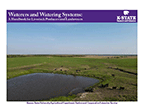Displaying 46 to 60 of 70 Publications
Waterers and Watering Systems: A Handbook for Livestock Producers and Landowners
by Carol Baldwin et al.
S147
Handbook assists in design of a watering system that fits the budget, site, and livestock needs. Water is provided by a water source, a power source, a pipeline to convey water, and the waterer itself. 173 pages, color.Revision Date: Apr 2024
Business-to-Consumer (B2C) Beef Company Marketing Claims FAQs
by Katie Lybarger et al.
MF3619
Publication describes the marketing claims that beef cattle producers may want to use to describe their beef. Some claims are regulated by the United States Department of Agriculture. 2 pages, color.Published Date: Apr 2023
Legal Requirements for Business-to-Consumer (B2C) Beef Sales
by Katie Lybarger et al.
MF3620
Publication describes the relevant licenses and inspections Kansas beef cattle producers may need to sell their beef directly to consumers. The three main pathways are: custom exempt; sales only in state of Kansas; or sales in Kansas and other states. 2 pages, color.Published Date: Apr 2023
Focus on Feedlots: Kansas Feedlot Performance and Feed Cost Summary: 2019 Annual Review
MF3247
Annual and seasonal trends in cattle performance, cost of gain, and commodity prices summarizing monthly reports from 2017-2019. 8-page, color.Revision Date: Sep 2020
Production Records for Cow/Calf Producers
MF3298
Production records that may be valuable for cow/calf producers with tips for selecting a record-keeping system and software. 4-page, b/w.Published Date: Aug 2016
Winter Wheat Grazing
by Kevin C. Dhuyvetter Glynn T. Tonsor
MF1009
provides cost-return of winter wheat grazing. 4-page, b/w.Revision Date: Apr 2014
Composition and Feeding Value of Cottonseed Feed Products for Beef Cattle
by Dale A. Blasi Jim Drouillard
MF2538
Nutrient composition and feeding management of whole cottonseed, cottonseed meal and hulls. This will help beef producers use cottonseed by-products, reducing costs of production. 22 p.Published Date: May 2002
Wheat Middlings Composition, Feeding Value, and Storage Guidelines
by Keith C. Behnke Gerry Kuhl Dale A. Blasi
MF2353
Optimal storage conditions and feed value of wheat middlings for livestock consumption.Published Date: Aug 1998
Soybean Hull-Composition and Feeding Value for Beef and Dairy Cattle
by Dale A. Blasi Evan C. Titgemeyer Jim Drouillard
MF2438
Nutrient composition and feeding of soybean hulls to livestock. 18 p.Published Date: Jan 2000
Nutritional Composition of Feedstuffs for Beef Cattle
MF3648
This publication summarizes the nutrient composition of feed ingredients for dietary formulation and evaluation for beef cattle. Feedstuffs considered commonly available to producers across Kansas are included, along with additional ingredients for which composition values are well documented. 12 pages, color.Published Date: Oct 2023
Crabgrass: An Alternative Cattle Forage
by Bruno C. Pedreira et al.
MF3644
Publication describes best practices to produce crabgrass from seed to provide grazing and hay to cattle. 4 pages, color.Published Date: Oct 2023
Alternative Burning Strategies: Effects on Cattle Performance, Grassland, and the Environment
by Jaymelynn Farney et al.
MF3251
Compares the effects of patch burning with traditional pasture burning (prescribed burning). Explores the viability of this practice for reducing greenhouse gas emissions from cattle grazing systems. 4-page, color.Published Date: Feb 2019
Grazing Management: Toxic Plants
MF3244
Cover crops are gaining popularity as annual forages but may pose risks for grazing livestock. This publication describes animal health problems associated with certain species. 8-page, color.Revision Date: Apr 2018
Summer Grazing Strategies for Stocker Cattle in the Kansas Flint Hills
by Clenton Owensby Walter H. Fick
MF3232
Learn strategies to improve profitability when grazing cattle in the Flint Hills. 8-page, 2-color.Published Date: Feb 2016
Kochia Toxicity
MF2949
Kochia (Kochia scoparia), known as fireweed or summer cypress, usually has good forage value. Toxicity may occur with both harvested and grazed plants if kochia plants are allowed to grow more than 18 to 24 inches tall or begin to develop seedheads. 2 p., color.Published Date: Nov 2010
Displaying 46 to 60 of 70 Publications
 Sign in
Sign in















